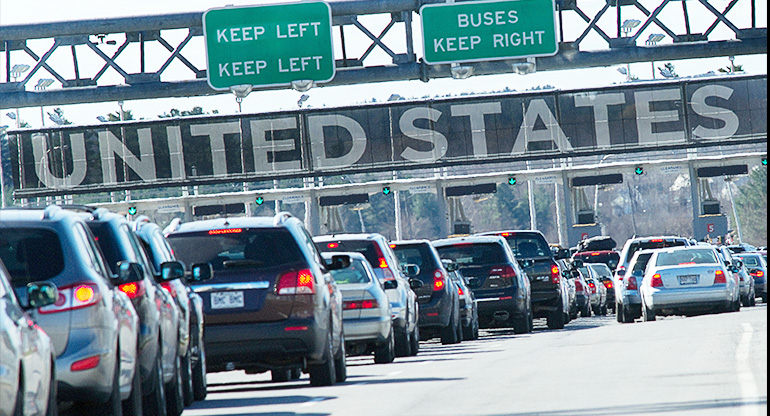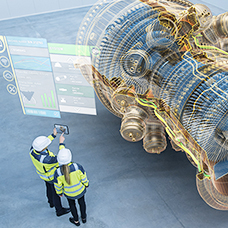 03-06-2024
03-06-2024
Key Takeaways:
- License plate recognition (LPR) is critical to CBP personnel's work, recording information automatically and allowing them to focus on inspections of vehicles and occupants.
- CBP's Land Border Integration (LBI) team tasked SAIC to modernize 700 legacy LPR systems across land ports of entry and checkpoints to improve read rates, reliability and adaptability for evolving needs.
- SAIC redesigned the LPR solution and deployed the new systems in under two years, ahead of schedule, while meeting the LBI team's performance and operational goals.
LISTEN TO THIS BLOG:
U.S. Customs and Border Protection (CBP) is responsible for securing the borders of the United States while facilitating lawful international trade and travel. This responsibility includes safeguarding more than 300 land, air and sea ports of entry. Every day nearly a quarter-million vehicles seek to enter the U.S. through the land crossings at our southern and northern borders. CBP officers inspect every single private car and commercial truck to ensure that the occupants and cargo they carry are admissible.
The inspection process includes capturing license plate information prior to the vehicle arriving to a CBP officer or agent. Each vehicle inspection lane has a standard set of equipment that captures front and rear license plates, takes driver and scene images, and reads RFID-enabled travel documents. License plate recognition (LPR) reduces manual entry by CBP agents and officers, resulting in focused attention on the vehicle and occupants.
The role of LPR is critical to CBP’s mission and field operations. Since 2008, SAIC has supported CBP’s Land Border Integration (LBI) team in developing, deploying, and maintaining LPR solutions which enhance security and efficiency in the inspection process. We deploy and maintain 700 LPR systems at more than 100 of the busiest land border crossings and U.S. Border Patrol checkpoints nationwide.
Along with reading license plates as vehicles approach inspection lanes, SAIC is responsible for the RFID sub-systems that are fully integrated within the LPR systems. For each vehicle, the in-lane system sends a data package with images and other data that are displayed on an officer’s workstation for processing prior to an inspection.
For over a decade, our work involved operating and maintaining CBP’s legacy LPR solution. In 2020, we were tasked with a sweeping technology modernization initiative to replace all legacy systems to improve LPR performance, reliability and security while reducing the agency’s technology ownership cost. In addition, CBP wanted to accelerate the pace of deploying new and innovative technologies to meet emerging needs and raise inspection efficiency for shorter wait times for travelers.
“The pre-primary zone, where information is collected, is all about technology and capability,” said Greg Lobbin, SAIC program manager. “Officers are getting these important inputs prior to inspection because they need to be looking at travelers when vehicles reach them. The focus of the technology modernization was on improving read rates and system reliability.”
Re-architecting the solution and components
The legacy LPR solution required precise calibration of cameras for lighting conditions, focus and shutter speed. It also relied on specific vehicle timing and angles to read license plate information. The narrow capture zone and blind spots affected read rate consistency, while the system’s use of strobe illumination distracted drivers in some environments.
Presenting another challenge, the OEM solution constrained the ability to integrate evolving technology innovations on the market to quickly adapt the system to CBP’s changing operational and configuration requirements.
“It was a proprietary system with a closed architecture, so the modernized solution had to be platform-independent and use commercial off-the-shelf hardware and software,” Lobbin said. “We designed a flexible, open architecture system that would be lower in cost to maintain. We also configured the solution for different external environments across CBP’s ports of entry.”
The SAIC team, leveraging years of experience and technical know-how with the LPR mission, identified the best-of-breed components that a state-of-the-art solution required, including high-speed cameras, advanced processors, and even enclosure boxes. The team developed the solution with an open architecture to facilitate rapid upgrades.
Adding program value for the customer
Following a successful pilot phase and LBI’s approval of the solution, SAIC deployed the systems nationwide in under two years, ahead of schedule, resulting positive mission outcomes that included read rates that exceeded CBP’s performance standard.
While all port-of-entry inspection lanes follow a standardized design, small variations exist and different locations have their own environmental conditions, so we ensure that individual LPR systems are configured to operate efficiently. For example, on the southern border, LPR equipment must withstand extreme heat and insects, while in Alaska, system enclosures run the risk of turning brittle and cracking under subzero temperatures.
The open architecture LPR solution was developed at a lower cost than a proprietary OEM solution while also reducing implementation timelines. The solution is more readily adaptable to CBP’s different LPR configurations, and the open architecture has accelerated innovations.
“What drove this success was being able to partner with our customer to think outside the black box of an OEM solution model,” Lobbin said. “Our customer said, ‘Make it happen’ — right in the middle of the COVID-19 pandemic. Now, we have an open architecture solution that eliminated vendor lock-in and exceeded performance measures.”




